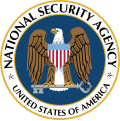CONUS Intel scandal
This article is an orphan, as no other articles link to it. Please introduce links to this page from related articles; try the Find link tool for suggestions. (June 2025) |
 National Security Agency surveillance |
|---|
 |
The CONUS Intel scandal, sometimes also called the Army files scandal,[1] was a minor political scandal in the United States involving the Department of Defense and National Security Agency that revolved around covert, illegal[1] domestic surveillance and the DoD's subsequent concealed use of ARPANET, belonging to its agency, now DARPA, coordinated with the NSA to evade Congressional orders with regard to information collected during the Johnson and Nixon administrations.[2][3][4]
Background
[edit]The Cold War US policy-making climate allowed for the "red hunt" in the form of the overarching FBI COINTELPRO program mandate to "win defections" within the weakened US Communist Party. On the heels of other similar FBI, CIA, and NSA direct and indirect surveillance programs operating in the US concerning "anti-war sentiment", as well as the demands of President Lyndon B. Johnson's advisors to find out "how and why demonstrators [were] so well organized", Army intelligence, in immediate response to Black rebellions in urban ghettos, set up its CONUS INTEL program in late 1967, with 1,500 Army intelligence agents monitoring protest groups and events all over the country. Between 1967 and 1970, the Army had files on "at least 100,000" US citizens.[1]
1971 Senate subcommittee hearing
[edit]Law professor, former Army captain in intelligence and journalist Christopher Pyle’s disclosure of the CONUS INTEL program immediately led to the first full-fledged Congress inquiry into intelligence affairs.[1][5]
In a Senate subcommittee chaired by Senator Sam Ervin, Pyle testified that the US Army was taking "spot report" dossiers on "between seven and nine million" US citizens participating in "demonstrations, protests and various kinds of civil disorder, which happen to mention someone whose security clearance dossier is on file".[6] MIT campus newspaper The Tech reported that, "according to reliable sources," the information was stored in the US Army Intelligence Command Headquarters at Fort Holabird, Maryland, and, "according to intelligence sources," transferred and stored at the National Security Agency headquarters at Fort Meade, Maryland. "The Army files [collected during the Johnson and Nixon administrations] were transmitted on the ARPANET in about January 1972, sources [that include former military intelligence officers] say, more than two years after the material—and the data banks maintained at the Fort Holabird facility—were ordered destroyed [by Congress]."[7]
Aftermath
[edit]Pyle and Ervin continued to investigate government activities; together with the Church Committee inquiries, these Congressional studies led to the drafting of the Foreign Intelligence Surveillance Act.[5]
See also
[edit]- ECHELON, SHAMROCK, RESISTANCE, HTLINGUAL, MINARET, MERRIMAC
- COINTELPRO
- Warrantless searches in the United States
Notes
[edit]- 1.^ E.g. The Tech[7] and ACLU lawyer John Shattuck[8] used the neologistic idiomatic proper noun adjunct Army instead of the possessive proper noun Army's at the time
References
[edit]- ^ a b c Tréguer, Félix (21 November 2023). "From Radical Contention to Deference: A Sociogenesis of Intelligence Oversight in the United States (1967-1981)". HAL: 29. Retrieved 12 May 2025.
- ^ "Army Spied on 18,000 Civilians in 2-Year Operation (Published 1971)". The New York Times. 1971-01-18. Retrieved 2025-06-04.
- ^ "Spying on Americans: Infamous 1970s White House Plan for Protest Surveillance Released | National Security Archive". nsarchive.gwu.edu. Retrieved 2025-06-04.
- ^ "Surveillance of Citizens Stirs Debate (Published 1970)". The New York Times. 1970-12-27. Retrieved 2025-06-04.
- ^ a b "US 1070-1-17: The CONUS Intel Scandal – Timeline of Intelligence Scandals". GUARDINT. Retrieved 2025-06-04.
- ^ Pyle, Christopher (February 24, 1971). Federal Data Banks, Computers, and the Bill of Rights: Hearings Before the Subcommittee on Constitutional Rights of the Committee on the Judiciary, United States Senate, Ninety-second Congress, First Session, on Federal Data Banks, Computers and the Bill of Rights ... U.S. Government Printing Office. p. 177. Retrieved 12 May 2025.
- ^ a b D. Sandler, Norman; McNamee, Mike (April 11, 1975). "Computers carried Army files; MIT investigation underway" (PDF). The Tech. Vol. 95, no. 17. Archived from the original (PDF) on 25 August 2014. Retrieved 12 May 2025.
- ^ Greider, William (February 1975). "Soldier, Agent, Tax Man, Spy" (PDF). The Washington Post. p. 18. Archived from the original (PDF) on 5 July 2024. Retrieved 12 May 2025.
